Mike Vardy's Blog, page 76
February 9, 2016
Why I Stopped Doing GTD: Part 1
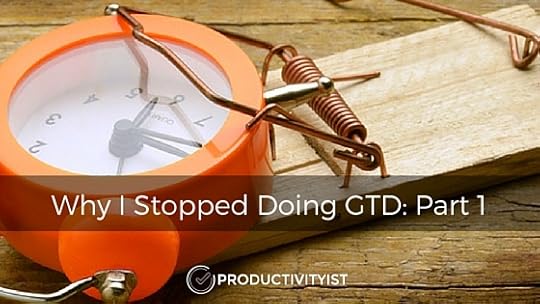
This is a piece that was originally published in The Productivityist Weekly newsletter. I wanted to share it with you on the blog as well to explain why Productivityist no longer writes or focuses on the GTD methodology. If you would like more updates, Click here and you’ll get it delivered to your inbox every week.
So I’m no longer practicing Getting Things Done.
To be fair, I haven’t been practicing GTD in its purest sense for over a year and a half now. Over the past few weeks, I’ve concluded that only a few remnants of the GTD methodology will remain as part of my productivity system. Those remnants largely revolve around capturing everything that comes to mind, being deliberate with my inboxes, and reviewing my tasks and projects regularly (a hybrid version of the Weekly Review, I suppose).
So why did I abandon GTD?
I left GTD behind because several aspects of it simply stopped working for me. There are likely more reasons than what I list below, but there are three that stand out. Over the next three weeks, I’m going to offer up more details on each of those reasons. So let’s get into the first reason why I’m leaving GTD behind…
It’s too complex.
The thing is, GTD is actually simple in a lot of respects. But there are elements of it that are complicated or involved, and that is where I find that I struggled with it on a regular basis.
I know I’m not alone in that.
I’ve had many Productivityist Coaching clients who have tried to use GTD in the past only to feel overwhelmed due to aspects of the methodology. A lot of that overwhelm comes from list-making. Not the number of items on lists, but the number of actual lists. GTD involves a lot of lists.
Making lists is pretty simple, but having too many lists complicates things. When you have too many lists, some lists are bound to be neglected.
The lists in GTD can generally be identified as follows:
Action Items. This is a list of all of your tasks. The sheer number of items on here alone can cause people to shudder – or even worse – run away screaming.
Projects. This list is a container of sorts which takes related actions and groups them under a common initiative. This list is less overwhelming at first glance because it should contain less items. But once you look inside all the containers, it can really cause anxiety. Most people work by project, which isn’t often the best way to work.
Contexts. This list another container, but it groups action items differently than projects. Instead, it groups tasks by what you need to have at your disposal (location, tool, resource, etc.) in order to complete the task. Because a lot of folks can’t understand the term contexts well, it tends to be underused… and undervalued. The traditional idea of contexts doesn’t apply all that much anymore, either. With laptop computers, tablets, and smartphones the context “computer” isn’t as useful. (This is just one of the things that I discussed with GTD founder David Allen on this episode of The Productivityist Podcast.
Horizons of Focus. This list is also a container of sorts, but it looks not just at today but to the extreme long-term. Most of the people I’ve encountered don’t plan that far ahead, so they tend to climb no higher than the 10,000 feet level despite the fact that the Horizons of Focus rise to 50,000 feet. So even though GTD can support the larger plan you have for your life, most people just want to focus on what they need to get done today (or this week).
These four lists can be overwhelming, and the lists that (in my experience) get neglected the most are Contexts and Horizons of Focus. These are the most critical lists to help you do the right things at the right time and to achieve goals over the long term.
There are very few people out there (relatively speaking) that have GTD so ingrained in their lives that it comes easy to them. Even the most die-hard GTDers fall off the wagon and can struggle with getting back on it. I’ve been one of those, but I’m using my own wagon now. There are a number of reasons for that as well, but the primary reason is this: it’s simpler.
(By the way, I’ll share more about “my wagon” with you once I’m done offering up the remaining two reasons why I’ve stopped practicing the GTD methodology. Until then, let me know what part of GTD works for you and what part doesn’t. I’d love to hear your thoughts in the comments below.)

February 8, 2016
The Productivityist Podcast 79: Think Productive with Graham Allcott
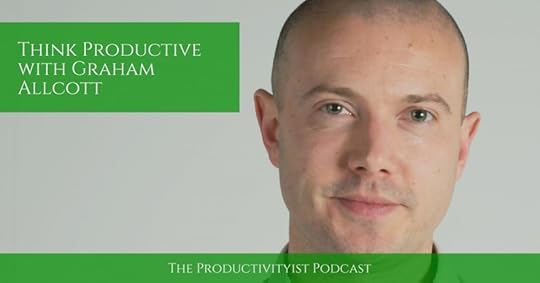
On this edition of the podcast, I speak with founder of Think Productive and productivity ninja Graham Allcott. We focus on the nine characteristics you need to have to become a true productivity ninja and dive into a myriad of other offshoot topics as a result.
I had a lot of fun chatting with Graham and I’ll be having him back on in short order to dive deeper into even more!
Relevant Links
Think Productive UK
How to be a Productivity Ninja by Graham Allcott | Amazon
The Productivityist Podcast 77: Chris Bailey
Plagiarists’ Corner | Stewart Lee
9 Characteristics of a Productivity Ninja | Think Productive
Nozbe
Headspace
Think Productive (@thinkproductive) | Twitter
Graham Allcott (@grahamallcott) | Twitter
Thanks to Transpose for supporting this week’s episode. It’s a fantastic software as a service solution that you’re going to want to check out. To learn more about Transpose, click here.
Enjoy the podcast and want to help make it even better? Then support The Productivityist Podcast by becoming a patron! Click here to visit The Productivityist Podcast’s Patreon page and choose from a wide variety of perks – including a limited number of monthly 20 minute coaching sessions with yours truly available only to Patreon supporters!

February 4, 2016
Too Busy To Think: 6 Ways To Create More Space
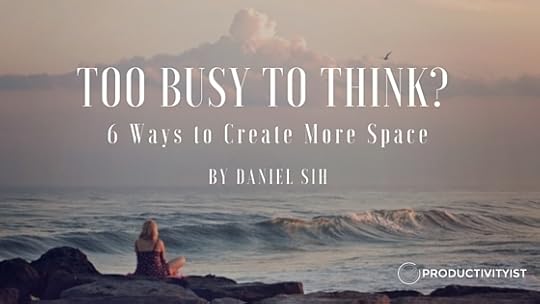
Daniel Sih is the co-founder of Spacemakers, a productivity and time management company in Australia. He is also the creator of EmailNinja, an online inbox zero training solution for busy people. You can read his blog at www.spacemakers.com.au/blog/.
When I was young, my one of my teachers would say “Practice makes perfect.”
He suggested that if I were to become good at anything – sports, career, or counting cards – then I would need to practice, practice, practice.
This seemed logical at the time. I mean, who was going to argue with Mr. Robins?
Yet now, I wonder if this was overly simplistic.
Does practice alone make perfect?
Practice and Sport
Imagine this. You’re a tennis player and have fifteen minutes left at the end of your weekly lesson to work on your serve.
How will you maximize your time?
Option 1. Hit as many serves as possible for the next fifteen minutes. In other words, practice again and again, doing more.
Option 2. Hit just a few serves and then spend the rest of your time analysing and thinking about your stroke.
Both approaches take the same amount of time.
Both are logical.
But which approach will maximize your Federer slice serve for that big game?
Whether a tennis fan or not, this dilemma is surprisingly common. I bet you come across it every day at work and in life.
Practice and Work
Does this sound familiar?
It’s 8am on a Monday morning and another week has begun.
Your calendar is stacked with meetings. There is a big deadline is looming. And a bunch of new emails have already arrived in your inbox.
What’s the best way to use your time?
Do you dive straight in and plough through as much work as possible? Or will you hold back for an hour to reflect on your priorities and to plan your week?
This is the moment of choice.
When stretched for time, most people tend to drop thinking and planning in their calendar to complete as many tasks as possible. According to this Finnish study of 1500 office workers, 70% of employees do not plan their week.
Yet like the tennis player who practices again and again without reflecting, is this really the best way to work?
Does practice really make perfect?
When pressed for time, is it better to a) do more tasks or b) reflect on your work before moving into action?
In 2014, a Harvard research team, led by Giada Di Stefano tackled this question. They recruited people to complete several mathematical brainteasers and financially rewarded those who performed best.
To prepare for this experiment, each participant was given a choice to either:
Practice lots of brainteasers for 3 minutes.
Do a puzzle and then spend 3 minutes thinking and reflecting on their performance.
Practice makes perfect doesn’t it? Well, it seems that most people think so — 82% chose to practice as many puzzles as possible, whereas only 18% traded practice time for the opportunity to think.
And the results?
Thinking + doing (the 18%) outperformed the rest of the crowd, hands down.
“If individuals themselves are given the choice to either reflect or practice, they prefer to allocate their time to gaining more experience with the task — to the detriment of their learning.” HBR research team
Doing a lot of tasks or practice might feel more productive because you seem to be moving forward.
But stopping to think, as a compliment to doing, leads to far better results.
Too Busy To Think?
“I’m too busy to plan my week. I know it’s important, but I just can’t find time.”
Ever thought this before?
As a productivity coach, I meet leaders and managers at all levels who struggle to stop and think. They feel time pressured each day and therefore respond by doing more and more.
This might seem productive, but in the long run, it’s self-defeating.
Like the tennis player who stops to analyse their serve, or the mathematical wiz who reflects on a brainteaser, the best performers at work and in life are those who prioritize time for intentional thinking.
They brew on ideas. They stop to think. And they outperform in life.
Build New Habits For Intentional Thinking
As a husband, father, and business owner, I take thinking very seriously.
I consistently guard time in my calendar for thinking, planning and refreshing. I consider these times to be both very important and valuable to me.
Here are six daily, weekly, and annual habits that I have developed that give me more space.
1. Daily Exercise. Research shows that exercise makes you smarter, more alert and more capable of learning new things. It literally grows your brain by maximizing brain health.I intentionally choose forms of exercise that maximize my ability to think. These include riding a bike to work (visualizing my day in advance), swimming (counting time, not laps, so that I can think) and exercising at the gym (listening to podcasts to learn new things). By starting each day with activity, I enter the day feeling fresh, focused and clear about my daily priorities.
2. Daily MIT’s. This stands for Most Important Tasks. Each morning, I make a mini-plan (10 minutes) to review my to-do list, my email action folder and my calendar, to determine my 3 Most Important Tasks for the day. These don’t have to be big tasks, just important one’s. For me, this habit functions like a mini-retreat before I check my email. I get to think about what I’m doing and understand what I need to achieve for today, all before the storm hits.
3. Weekly To-Do List Planning. Every Sunday night I plan my week. I review my calendar, update my to-do list, determine and then schedule my priority tasks for the week. This rhythm ensures that I’m intentional and proactive in how I approach my life. It forces me to plan a next step on any hard-to-move projects. It helps me to stay organized and feel more in control. I don’t necessarily do any tasks during this time; it’s just a space to think, plan and clarify my priorities for the coming week.
4. Weekly Digital Detox. Each Saturday I down tools and take a digital detox. I intentionally disconnect from my devices (smartphone, iPad, laptop etc.) in order to find space to reconnect. Whenever I unplug from technology for a day, I find that I enter the week refreshed and recharged. I feel less busy and think more clearly. To find out more, here’s Why I End Each Week With A Digital Detox.
5. Silent Retreats. Once a quarter, every Summer, Autumn, Winter and Spring, I dedicate an entire day to practice contemplative thinking. During this time, I walk along the beach and think about whatever happens to have my attention at the time. Sometimes I drink a coffee at the local cafe in silence. I also walk around a garden (that I hire for the day) with my journal and reflect on where I’ve been, where I am now and where I want to be. This helps me to recalibrate, to clarify my goals and to unblock challenges or opportunities across my life.
6. Family Holidays. As a principle, I book my holidays before I book my work. For example, I begin each year by booking at least two family retreats before any client gets an appointment in my calendar.After five years, these retreats have become habit. My family rents a beautiful shack by the sea, surrounded by cows and bushland. My mind quiets down as I stoke a wood-fire, relax in an outdoor bath, amble along the beach or play hide-and-seek with my kids… all without access to the internet. It’s great for my family and great for me. The routine helps me to slow down and think.
Stop Doing And Get Thinking!
Thinking and reflecting is not a hors-d’oeuvre to compliment the main meal. It’s actually the meat and potatoes.
Even the busiest people are more productive when they carve out space in their calendars to stop and think.
Research shows this. Experience backs it.
Practice + Thinking = Perfect
Set aside time to think and reflect before you start doing and you’ll make space to be productive.
Question: Tell us about your habits for intentional thinking!
The post Too Busy To Think: 6 Ways To Create More Space appeared first on Productivityist.

February 2, 2016
How to Set (and Stick to) Boundaries for Better Productivity
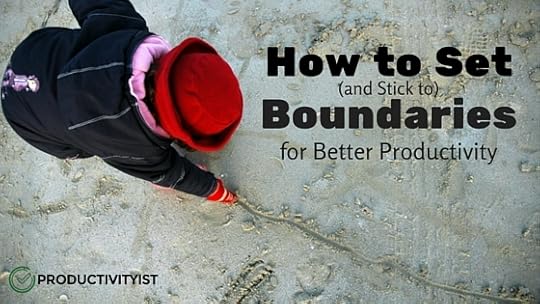
I’ve spent some time over the past few weeks setting better boundaries for myself and for Productivityist. The ideas in my mind, in addition to my normal workload, were weighing me down. It was time to get rid of some of them in order to move forward.
So after careful consideration, I made some pretty bold choices:
I decided to remove Do Better with Asana from our offerings. I have found someone who is willing to take what Jeremy and I created and reinvigorate it themselves. It was tough to part with this product because I know it will help people, but it’s no longer a fit for me (or Productivityist).
I’ve made a commitment to write less about how to use productivity apps and more about how to incorporate elements of The NOW Year™ Method into productivity apps instead. I’ve long said that the approach is more important than the app and I want to make sure that the direction of my writing and Productivityist aligns with that. That doesn’t mean I won’t discuss apps from time to time, but they won’t be a focus. Considering that a lot of visitors come to this site because they are looking for help with apps, the short-term effects of going this route may be felt in terms of lost traffic. But I believe that over the long-term, the benefits of drawing this line in the sand will be great.
The focus on products will be to update and upgrade existing ones rather than to create new ones. Any that no longer fit the vision of Productivityist will be revamped or retired. Some of the books I’ve written will be available elsewhere (Amazon, Noisetrade, etc.) but not through Productivityist. Some of the books that Productivityist will create won’t be available anywhere but through Amazon. I’ve crafted a very specific product development plan that we’ll use and the primary objective will be to make those products that I want to offer bigger and better than before.
These are just three ways I’ve started to set boundaries for myself and for Productivityist. There are many others that I’ve put in place, but I wanted to share the first three with you because that is one of the ways you can stick to the boundaries you’ve set.
Share Your Boundaries
When you make your boundaries widely known, you can be held accountable to them. Sometimes it isn’t enough to have them kept to yourself or held privately. Like habits and resolutions, sometimes you need to make boundaries known so that you feel compelled to stick to them so that your integrity and honour don’t suffer. Another benefit of making your boundaries known in public is that others will see what you are willing and not willing to do, which can result in less time explaining those things to them.
One of the other things I’ve done is I’ve followed the lead of Derek Sivers. He started The Now Page Movement and I’ve created a Now page on my own website.
This page clearly outlines what I’m doing right now and really puts my boundaries out there for everyone to see. We’ll be creating a Now page at Productivityist soon, where we’ll share what we’re up right now as a company and as individuals.
Simplify Your Boundaries
The simpler your boundaries are, the better. That’s one of the reasons why I love the idea of using themes for boundaries.
Creating a boundary for every day of the week can be incredibly freeing – ironic as that may sound. I know every morning when I wake up what the theme of the day is, which is essentially a boundary. It doesn’t mean I will only do those items that carry that theme (that doesn’t happen as often as I’d like) but the theme creates a boundary that I return to when I’m taken off of that track.
Themes are easy to remember. Instead of thinking about everything I have to do on a given day, I only need to recall what theme that day has and I’m able to pay attention to my intentions with ease.
Themes are also simple to adjust. I was able to shift what I did on a Sunday to Wednesday quickly all through swapping the themes for each day. It didn’t take long for my task management solution to follow that rhythm and align with the new daily themes.
When you have simple boundaries you can be agile and nimble. And that almost always leads to better productivity.
Celebrate Your Boundaries
Setting and sticking to your boundaries is far easier if you take the time to celebrate them. The reason you’ve put them in place is so that you can live up to the sixth tenet in The Way of The Productivityist Manifesto: Take the time to create space for yourself and you’ll create the space to make time for yourself.
Want a copy of The Way of The Productivityist Manifesto? You’ll get it and several bonuses when you sign up for the Productivityist Weekly, a newsletter crafted by yours truly that I deliver to your email inbox every week. Click here to get the manifesto now.
As of this writing, I’m one-third of the way through the Whole30 Program. I chose this nutritional plan not only because I found it to be simple in how it is laid out (only meat, vegetables, and fruit – nothing else – over a thirty day period) but because I found that the benefits of going through the program would give me reason to celebrate. (I also chose it based on the recommendation of Courtney Carver, who writes about how to have a simple and successful Whole30 here.)
The hope is that it will give me a healthier body and mind, enhanced fitness and clarity, and more. I’m actually celebrating it along the way – hitting a tenth day with no sugar is huge milestone for me. The boundaries of the Whole30 have created a celebratory atmosphere…as long as I stick with it.
I don’t feel bad about the boundaries I’ve set. Whether they are related to dietary changes, productivity frameworks, or even my own availability to others. I celebrate the fact that they are in place. They protect my intentions and attention which allows me to protect my energy and my time. Boundaries allow me to get more of the right things done – the things I need and want to do – and eliminate the idea of things I “ought” to do. With boundaries, there are less things that I feel I “ought” to do.
I now have more certainty within my days, my weeks, and my months. I can deal with uncertainties better. I can deal with life better.
Boundaries are one of the best ways you can make an immediate impact on your productivity. So go and set some shareable, simple, and celebratory ones for yourself today.
The post How to Set (and Stick to) Boundaries for Better Productivity appeared first on Productivityist.

February 1, 2016
The Productivityist Podcast 78: Annie Mueller
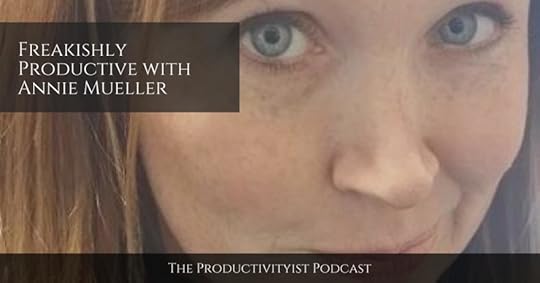
In this episode I chat with Annie Mueller from Freakishly Productive about tactical time management tips. We discuss how Annie is able to be productive while homeschooling four kids and running a business, and a whole lot more.
Some of the highlights include:
Women in productivity: Where are they and why Annie thinks there is a stigma
Categorizing by energy levels: Energy fluctuations and working with them
Homeschooling: How to use things like Minecraft and how it can help with productivity
To Do Lists: Short or long, should you include routine tasks or not
Capturing ideas and thoughts
Can you apply her method to a 9–5?
Why not being afraid to change the narrative will help your productivity
Relevant Links
Freakishly Productive
The Productivityist Podcast 55: The Productive Woman with Laura McClellan | Productivityist
Bullet Journal
Categorize your work into energy levels | Freakishly Productive
Simple to complex, complex to simple | Freakishly Productive
The two worst enemies of good time management | Freakishly Productive
Try to capture all the ideas | Freakishly Productive
Annie Mueller (@AnnieMueller) | Twitter
Thanks to Transpose for sponsoring this episode of the podcast. Click here to learn more about what Transpose can do for you and your productivity.
Enjoy the podcast and want to help make it even better? Then become a patron The Productivityist Podcast through our Patreon campaign! Check out The Productivityist Podcast’s Patreon page and take a look at all of the perks – including a select number of monthly Productivityist Coaching sessions with yours truly – available only to Patreon supporters!
The post The Productivityist Podcast 78: Annie Mueller appeared first on Productivityist.

January 28, 2016
Why Reading Leadership Books will Boost Your Productivity
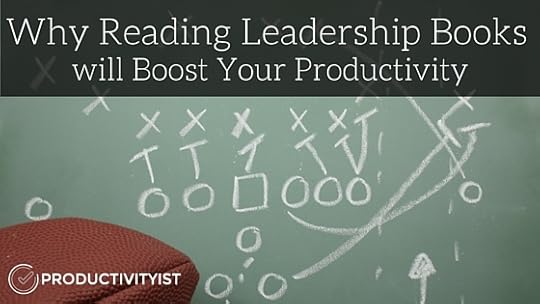
I’ve been reading a lot of books on leadership lately, something that I really haven’t done all that much before. Historically, I’ve read mostly time management, productivity, and technology books. While these have helped shape my skill set and knowledge, I’ve recognized that anyone who is interested in boosting their productivity needs to read leadership books as well.
One of the most important reasons to read leadership books is you can take the lessons you’ve learned and then applying them to yourself.
To put it simply, in order to lead others effectively, you need to lead yourself first.
I learned this lesson through just one particular book on leadership: The Score Takes Care of Itself: My Philosophy of Leadership by Bill Walsh. (It somewhat pained me to read the second one as the late author was the legendary coach of the San Francisco 49ers — a team that beat my Cincinnati Bengals in two Super Bowls — but he also did coach for the Bengals, so I kept that in mind as I poured over the pages. Now that I think about it, if he’d only stayed with the Bengals maybe we would’ve won a few already…)
There were plenty of takeaways I got from Bill Walsh’s book. For example, Walsh praises the virtues of creating frameworks and boundaries, as well as “scripting” — the notion of setting things up in advance so that your chance to success is much greater than if you just go by the agenda to presents itself throughout the game (or in our case, the day).
He also focused on the importance of being consistent, which is definitely something you need to keep in mind if you want to not only get through daily tasks but also to complete larger projects and achieve much loftier goals.
The reason these leadership books are so helpful is because of the ideas and insights that they present. What makes them so powerful is that you get to read about the results of implementing such tactics.
Bill Walsh is a Hall of Fame football coach who essentially invented the offense that anyone watching professional football sees today. The results of setting himself and his team up for success is inspiring and has motivated me to lead myself even better so that I can lead others better.
Walsh also spent plenty of time doing what he calls “organizational archaeology.” This is digging deep into things so that you can look back and course correct as well as plan for the future in a positive and results-oriented way.
This is an approach we all need to implement to make sure we are accomplishing what we need to accomplish and ultimately doing more of what we want to do. The process of digging deep into our to do lists, calendars, and notebooks allows us to make better decisions. Then we can focus on finding the positives within the negatives.
Walsh found improvements on his offense despite having a losing record in his first two years. He felt ready to give the reins over to his quarterback of the future, Joe Montana, after analyzing completion percentages and interception ratios between his veteran starter Steve DeBerg and the young Montana. Walsh found out where the holes were and took strides to fill them in a way that wasn’t knee-jerk but measured. That’s why his defense went from near the bottom of the league rankings to second overall the following year.
This organizational archaeology also played a big role in why they won the Super Bowl in his third year as well.
He’s willing to make the tough decisions. Walsh writes about having to cut players who were quite good but not ideal for his system. Walsh shares about how Joe Montana felt when Steve Young was acquired to eventually replace him. He writes about letting players go that were almost past their prime so that he could build for the future and seeing little to no attrition while doing so. He hated doing it most of the time, but he did it because he knew it was for the good of the organization.
When it comes to being purely productive, we need to be willing to make the tough calls. We need to say “no” when appropriate (which is likely more often than we admit). We need to cut out things that aren’t working anymore, be it tools, resources, or even people. We don’t have to like doing it, but doing it allows us to do the things we need and want to do better. We do it for the greater good.
Walsh was patient. While it only took three years to go from losing franchise to Super Bowl champion, he didn’t think they’d win it that soon. Walsh was prepared to wait another two to three years before winning a championship was realistic. But his patience with the framework he developed and resources used within the framework allowed him to reach greater heights far quicker than even he imagined.
There is no “magic bullet” for enhanced productivity. No app will do it for us alone. We need a framework that we set up in advance that will support us. We need resources that will aid us in working efficiently and effectively. Resources that will thrive within the framework. But we also need to give them time to take hold and do their thing. We can’t be switching from app to app or fiddling with our framework every time something new comes along. We need to be patient.
I’ve only read a few leadership books so far, but I’ve come to realize that I get a lot more out of them than just some leadership ideas I can use with my team. I find that I get ideas I can use on myself – to make myself better. I find that reading leadership books don’t just boost my productivity. They help me move things forward in a more consistent way. They help me craft frameworks that are nimble enough to be used by many, but they have to start with me.
“Consistent effort is a consistent challenge.” – Bill Walsh
I may not be a fan of the San Francisco 49ers, but I am a fan of Bill Walsh. And while I recommend The Score Takes Care of Itself as a great read on leadership, I have three other books to help you get started.
Looptail: How One Company Changed the World by Reinventing Business by Bruce Poon Tip
Making Ideas Happen: Overcoming the Obstacles Between Vision and Reality by Scott Belsky
Delivering Happiness: A Path to Profits, Passion, and Purpose by Tony Hsieh
I know there are plenty of others out there that I didn’t list. There are plenty more that I need and want to read. And I’m going to make that happen going forward.
If you want to boost your productivity, then you should make it happen too.
The post Why Reading Leadership Books will Boost Your Productivity appeared first on Productivityist.

January 26, 2016
What To Put On Your To Do List
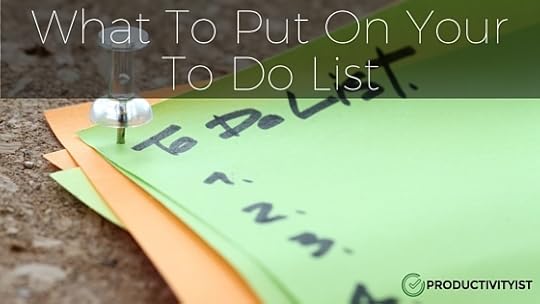
This piece was originally published in The Productivityist Weekly. Not signed up for the newsletter yet? Click here and you’ll get it delivered to your inbox every week and receive a copy of The Way of The Productivityist Manifesto absolutely FREE!
Over the years, I’ve had many people ask me what they should put on their to do lists. The thing is, this is not a simple question to answer. Each person treats their to do list differently.
Some people use their to do lists for the big things, so the smaller things never make it there – they just get done by default.
Others only put only work-related tasks on their to do lists. This is done mainly to avoid that feeling of restriction or attachment to their to do list when they’re not at work.
Some people only put the things they think of on their to do list. So things like email – from external sources – remain in the email program for storage and execution there.
So when I am asked that question, I normally try to figure out what someone puts on their to do list right now.
Still, the answer always winds up being the same.
Put everything – every single task – on your to do list.
Now let me be clear: some tasks can be done before they make it to the larger to do list. But I still capture all items on paper, instead of trying to keep track of them in my head.
Why? Because my head is a terrible long-term storage device.
I get every task out of my head. Where it goes is dependent on what it is. Ideas go to Evernote and they get reviewed whenever I go into Evernote Mode. And how do I know what to look for when I go into Evernote Mode? I look at my to do list.
I don’t put things like Garbage Day or Recycling Day on my calendar. Why? Because I don’t make dates with either of those things. My wife does put them on the calendar, and because of that, I can see when the pickup dates are. Then I put them where it serves me better: on my to do list.
Ultimately, it doesn’t matter what app or tool you use for your to do list. It’s the methodology that matters. And it matters that you use that methodology consistently, just like it matters that you capture consistently.
When you capture everything, you regret nothing.
I’m an edge case for sure, but I have super handy things in my to do list that repeat annually like “Put up holiday decorations” and “Research gift ideas for anniversary.” By doing this, I never need to think about remembering these things. I just need to do them when they show up. I can use that energy saved to do those things – and a host of other things – better.
The right level of awareness leads to taking the right action.
Your brain can’t really decide what truly matters at the moment that task or idea comes to mind. It can only do that later, when you have time to process the events. Give your brain a break.
So the next time you think of something that could go on your to do list, think twice. Because if you’re thinking that it could, then it should.
The post What To Put On Your To Do List appeared first on Productivityist.

January 25, 2016
The Productivityist Podcast 77: Chris Bailey
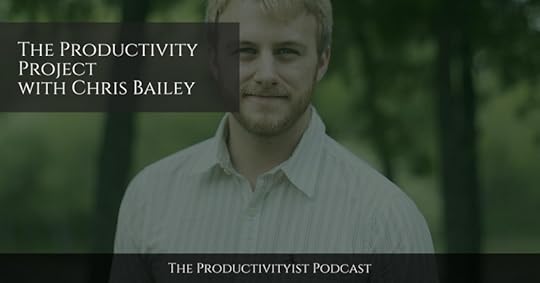
In this episode of the podcast I chat with the author of The Productivity Project, Chris Bailey. We talk about Chris’s new book, the process of writing the book, why quantitative and qualitative data are both needed to measure productivity, and whether or not Chris identifies as an early riser or a night owl.
Relevant Links
The Productivity Project: Accomplishing More by Managing Your Time, Attention, and Energy by Chris Bailey | Amazon
A Life of Productivity
Work the System: The Simple Mechanics of Making More and Working Less by Sam Carpenter | Amazon
ALifeofProductivity (@ALOProductivity) | Twitter
Chris Bailey (@wigglechicken) | Twitter
Thanks to Transpose for supporting this week’s episode. To learn more about what Transpose can do for you and your productivity, click here.
Enjoy the podcast and want to help make it even better? Then become a patron The Productivityist Podcast through our Patreon campaign! Check out The Productivityist Podcast’s Patreon page and take a look at all of the perks – including regular Productivity Pack deliveries sent every January, May, and September – available only to Patreon supporters!
The post The Productivityist Podcast 77: Chris Bailey appeared first on Productivityist.

January 21, 2016
Diving Into Deep Work
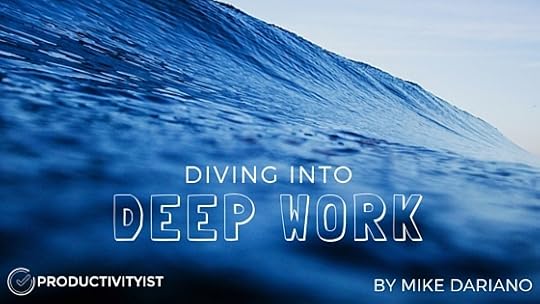
What is the most valuable work you do?
I’m willing to bet it doesn’t have to do with email, meetings, social media statuses or updating websites. Rather, your best work pushes you to your creative limits, generates value, and is of the very best quality.
Author Cal Newport’s new book Deep Work focuses on this kind of work. He defines deep work as work performed without distraction that pushes your cognitive capabilities to their limit. This is the work that creates value, improves your level of skill and is also hard to replicate.
When it comes to producing deep work, Newport suggests this formula:
High-Quality Work Produced = (Time Spent) x (Intensity of Focus)
Newport writes if you’re willing to do these things, then you’ll start to create work that stands out in a noisy world. But it won’t be easy.
There’s a constant whirlwind of shallow work that that begs for our attention. Shallow work feels fulfilling because it’s easy and requires little focus. This is the kind of work that is easier to multitask and doing it makes us feel productive. But in reality, this type of work is not as rewarding as deep work. Shallow work is like the sirens of the seas, momentarily gratifying but not the final destination you want.
To cultivate a deep work habit, here are a few guidelines from Newport:
Deep work is a skill. This skill must be developed before you can do it in an effective manner. Deep work is a lot like playing the guitar, not flossing your teeth. When you take this into consideration, it changes how you approach focus.
Quit social media. Social media is an “any benefit” activity. We think that if any benefit results from an activity it must be good. It’s not. It’s a distraction from deep work. Instead, use that time to further sharpen your focus on the richest parts of your life.
Do less shallow work. This will give you more control and also more clarity. Over time, continue to minimize the amount of shallow work you do.
Create rituals. This helps extract as much as possible from your brain. It also allows you to work on the right things at the right times in the right spaces.
Don’t confuse busyness with productivity. The rare and valuable things you do should be your metric for productivity.
End the workday at a certain time. Newport recommends closing up shop at 5:30. By creating a constraint you can focus your attention and resources during the workday.
Deep Work is a good starting point for anyone new to Newport or has been a fan (like me). You should read it right now, unless that is, you have a pile of deep work to get through first.
Ready to take these concepts even deeper? Check out Cal Newport’s conversation with Mike Vardy on the Productivityist podcast.
The post Diving Into Deep Work appeared first on Productivityist.

January 19, 2016
How to Get Back on Track in January

This is a piece that was originally published in The Productivityist Weekly newsletter. Not signed up for it yet? Click here and you’ll get it delivered to your inbox every week and you’ll also receive a copy of The Way of The Productivityist Manifesto absolutely FREE!
Those of you who have been following my work for a while know that I’m not a fan of starting the new year in January. There are several reasons behind this, but the primary reason is that I think trying to get something stellar started when you’re at one of the lowest points of energy in the year is very unwise.
That said, I know many of you make New Year’s resolutions. And that’s cool. But at this point I’m betting that many of you have let them fall by the wayside already, and we’re only three weeks into the calendar year. Let me be clear: there are many of you have kept up with your resolutions, and that’s great. But I know there are more that haven’t. And that’s also cool because I’m about to offer some ways to get back on track with the time left in January.
1. Get real
The reason you’ve fallen off the wagon isn’t because you’ve made one bad resolution. It’s because you’ve probably made unrealistic expectations regarding your resolution. You’ve either picked too many resolutions and fell down on the one that matters most to you or you picked a resolution that simply wasn’t something realistic at the time. Either way, you’ve got a problem. The problem: You didn’t get real with yourself when you chose your resolution.
To get back on track, you need to look back at why this happened. What led to you choosing this resolution — and what led to you breaking it. You need to figure what will work and what won’t. And you need to be honest with yourself on both fronts. Whether that means you were over your head when choosing that resolution or whether you didn’t give it your full effort, you need to get real and get honest. Then you need to decide whether you’re going to go forward with it. Then you need to do the next thing.
2. Get psyched
We’re three weeks into the new year. Now that the holidays are over, your energy levels are rising so you can take on bigger projects. For some of us, energy levels may have already increased a week or so ago. Regardless, we’re ready to give the resolutions that didn’t stick a second chance…a fighting chance.
Getting psyched does that. This is a great time to reevaluate any wayward resolutions. Once you take time to reassess the situation, decide what you are going to do. You can continue to grind through or you can give up. Maybe it is time to create a new resolution altogether. But that initial boost isn’t enough. We need to give our resolutions shelter over the long term. When you take that step, you commit to keeping them.
3. Get committed
Resolutions need a stable environment to survive. One that has a solid foundation built on the individual, and not a tradition like the beginning of the month tends to offer. Committing to keeping the resolution is key to making it stick because without taking a pledge to actively maintain the resolution, it will have a greater chance of failure as opposed to success.
The best way to commit to a resolution is to make sure that you have as few as possible to commit to while they still in their infancy. Over time, you can commit to more of them. But during this time of year, be sure to pick the most critical resolution and commit to it over all others. That will give you a better shot at making sure it sticks over the long haul.
I’d much rather build resolutions over the whole calendar year instead of picking several to start it off. This practice allows me to deal with things in moderation rather than extremes, which works far better in terms of efficiency and effectiveness.
So if you’ve fallen off the New Year’s resolution bandwagon, give the aforementioned tactics a try. This could be the last time you worry about getting back on track at this point in the month of January because you’ll be more aware of what you can – and should try to – accomplish the next time a new calendar year arrives.
The post How to Get Back on Track in January appeared first on Productivityist.




